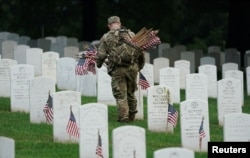Each Memorial Day, Washington, like cities across the U.S., offers events to honor members of the military who died while serving their countries — a parade through the streets, a ceremony at Arlington National Cemetery, and motorcycles rolling through the city. Alongside these widely known events are other services for Memorial Day, observed last Monday in May. One of these events honored indigenous service members.
According to the Defense Department, the first national ceremony was May 30, 1868, in Arlington National Ceremony. Then known as Decoration Day, flowers were added to soldiers’ graves. The holiday later became Memorial Day. Now, celebrations take place around the country, from city or county parades to larger scale events like those happening in Washington.
Some service members, however, particularly Native Americans, in the past have been overlooked in the remembrance.
Indigenous people have served in every major conflict the United States has fought in for the last 200 years, according to the U.S. State Department.
An event this Memorial Day, hosted by the Smithsonian’s National Museum of the American Indian, specifically honored indigenous service members who have died. Each year, the museum commemorates Memorial Day with a service, such as lighting the flame of their national Native American Veterans Memorial.
“Memorial Day: Honoring Native Servicemembers,” featured a film screening, a book talk, and a book signing. Visitors were also encouraged to explore the museum grounds and the National Native American Veterans Memorial, where they could both commemorate service members and honor loved ones.
The event began with “The Warrior Tradition,” a 56-minute film from 2019 directed by Lawrence R. Hott. It probes the often-untold story of indigenous people in the military and examines these service members’ tumultuous relationship with the U.S. government. The screening was held in the museum’s Rasmuson Theater.
Museumgoers then met author Alexandra N. Harris for a discussion of Why We Serve: Native Americans in the United States Armed Forces, a book co-written with Mark G. Hirsch. The book, which complements the National Native American Veterans Memorial, is a multimedia exploration that includes photographs, sketches, and images of objects from the museum’s collections.
The book tells the “groundbreaking history [that] honors the diversity of Indigenous people and the complexity of their experiences. In doing so, it challenges stereotypes commonly applied to Native service members and pays tribute to the men and women whose contributions have shaped America's wars — and the country's history,” according to the National Museum of the American Indian’s website.
“The story of Native American service in the United States military has really, I hope, expanded the view of Native American service to include the diverse traditional approaches and the diverse experiences of the last 250 years of service from the Revolutionary War until today,” said Harris to the Voice of America.
The Memorial Day commemorations are a microcosm of the larger, ongoing exhibition, Why We Serve, a project created by the National Museum of the American Indian. The project, which looks at the history of indigenous people in the service since the American Revolution, addresses the tension of individuals serving a government that has taken their people’s land and suppressed their culture. The interactive, online project explores the legacy of these service members and their reasons for joining the military.
“I found out I am not only fighting for the little bitty piece of land I talk about, [or] my immediate family. I found out I was fighting for all the Indian people, all of the people of the United States,” said Navajo Code Talker Samuel Tso, who served in the United States Marine Corps.
This Memorial Day, amid an afternoon of informational events, the plan is to continue the mission of the Why We Serve project to honor indigenous persons who have served and died during their time with the military.







